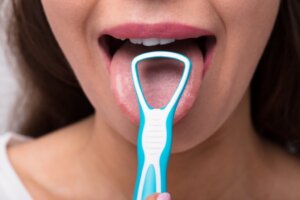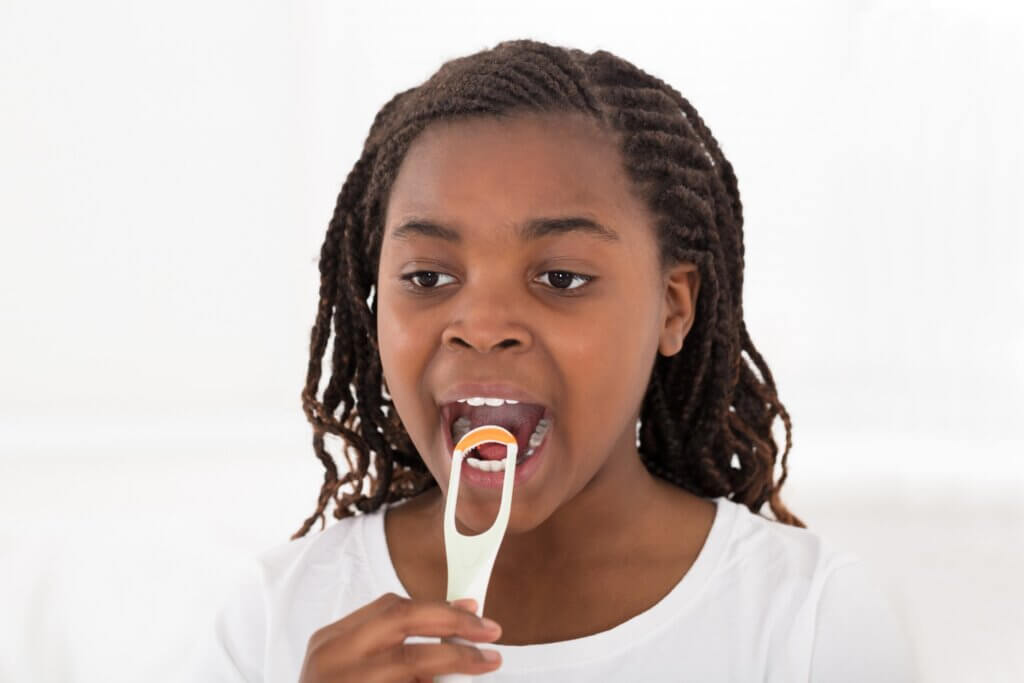The Importance of Cleaning the Tongue


Escrito y verificado por la odontóloga Vanesa Evangelina Buffa
Cleaning the tongue is of fundamental importance when it comes to oral hygiene. However, many people don’t focus on this aspect and, although they brush their teeth, they forget other parts and soft tissues of the mouth.
Oral hygiene is often equated to brushing the teeth. It’s a mistake that’s often made for many reasons; due to lack of information and for cultural reasons. Therefore, the gums, the mucosa of the cheeks, and the tongue are forgotten.
When talking about the importance of cleaning the tongue, we must also emphasize the mechanisms that allow us to maintain the hygiene of this organ. To do this, we’ll first review its anatomy and its functions so that we can later understand the relevance of proper care.
What’s the tongue like and what’s it for?
The tongue is an organ that’s made up of a large number of muscles. They’re covered by mucosa, which is what we see when we open our mouths.
It’s a part of the body with great irrigation. In other words, multiple blood vessels arrive and pass through its anatomy, which explains the pain and the amount of blood that becomes evident when we injure the tongue.
On the surface of the tongue are the papillae, which give it the characteristic velvety appearance. These are specialized structures that can help with taste and touch. In addition, some of them participate in the defense of the body through their communication with the lymphatic system, and others produce saliva.
The functions of the tongue are numerous. Among them, the most prominent are the following:
- Chewing and swallowing: Directs food toward the teeth to be crushed and then, helping in the formation of the bolus, moves it to the pharynx for its passage to the esophagus.
- Tasting: The tongue helps us perceive the taste and textures of food.
- Speech: Thanks to this organ, we can emit certain phonemes that help in our communication.
- Suction: For example, for babies, the tongue is essential in the process of breastfeeding, as it’s essential in achieving breastfeeding.
- Hydration: As we already mentioned, there’s a special participation in the production of saliva, which is why it promotes the correct humidity of the interior of the mouth.
Discover more: Tooth Sensitivity: Everything You Need to Know
The importance of cleaning the tongue to take care of its functions

After analyzing the anatomy and functions of the tongue, it’s clear that cleaning it is a necessary step on a daily basis to preserve its usefulness in the human body. In addition, we’ll be able to avoid associated diseases or problems that derive from inadequate care.
The tongue’s surface is capable of storing bacteria, dead cells, and food debris. If we leave them there for a long time, it’s logical to expect bad breath or even loss of taste.
This accumulation also leads to bigger problems that aren’t limited to the organ. There’s a hypothesis that a lack of tongue hygiene changes the microflora on its surface. Therefore, this could explain the increase in the risk of cavities in those people who don’t brush it; a risk that has been verified for more than 30 years.
What are the benefits of cleaning the tongue daily?
It’s possible to clean the tongue with a scraper, which is a specific instrument for the function, as well as with a classic toothbrush. There are also brushes that have a rough surface on their back specially placed there to scrape the tongue.
Ultimately, the important thing is to remember and practice hygiene. It can be complemented with a mouthwash that has fluoride or antiseptics. As we know from scientific evidence, rinses could be capable of changing the pH of saliva and tongue coating, which would favor the reduction of bad breath in healthy people with this problem. Below, we’ll share more benefits of cleaning the tongue.
1. Improves the sense of taste
The importance of cleaning the tongue is in the enhancement of taste. We already clarified that the organ has a preponderant role in this sense, so its correct hygiene will favor perceptions.
A clean tongue helps to better separate the sweet, salty, bitter, and sour flavors. Specifically, a study published in the Journal of Clinical Periodontology suggested that the use of the scraper increased the ability to taste in those who practiced scraping at least twice a day.
2. Removes harmful bacteria
The accumulation of pathogenic bacteria in the mouth will lead to an increased risk of certain diseases. Although there’s a normal microflora that persists in balance with the human body, the lack of hygiene breaks this homeostasis, which can exacerbate the growth of bacterial colonies capable of causing damage.
The importance of cleaning the tongue at this point lies in its power to remove substrates that microorganisms use to multiply. For example, an experiment published in Tropical Dental Journal found that tongue scraping for only 7 days was capable of reducing the salivary count of Streptoccocus mutans and Lactobacillus spp.
Discover more: Gingivitis: Symptoms, Causes and Treatment
3. Reduces bad breath
Film on the tongue is the main cause of halitosis (bad breath). It’s a white and gray deposit that forms on the surface of the tongue due to a lack of proper hygiene. From there emanate significant amounts of volatile sulfur compounds, which are identified as responsible for the bad smell.
By eliminating germs and food remains, the coating doesn’t form or does so in much less quantity. Therefore, tongue cleaning is the most efficient, economical, and simple method to control halitosis.
Here, it’s worth emphasizing that scraping is the mechanism that provides the greatest benefits against bad breath. While mouthwash provides momentary fresh breath, it should be combined with a scraper for long-term, persistent results.
4. Improves aesthetic appearance

A dirty tongue isn’t pretty to look at. This can generate social rejection, but also concern and discomfort in the self-esteem of the person who notices how the coating accumulates.
There’s a special situation that’s known as hairy tongue. In itself, it’s an excessive accumulation of keratin on the papillae. This makes it look like the tongue has black hair on it.
The disorder is benign and can be solved with proper hygiene. By removing excessive keratin with a scraper or brush, the appearance is noticeably improved.
5. Cleaning the tongue promotes general health
The hygiene and health of the whole mouth influence the general condition of the body. There are different hypotheses and theories that attempt to explain the link. And not only against acute diseases, but also against the development of chronic diseases that could be initiated or exacerbated by poor oral health or by the presence of bacteria in the microbiota of the tongue.
Mental health shouldn’t be neglected here. By improving aesthetics and controlling bad breath, the person is able to relate to others from another perspective. They suffer less rejection and their self-image is strengthened.
Steps to clean the tongue correctly
Finally, these are the essential and basic steps to take care of the tongue on a daily basis:
- Brush and floss your teeth as usual.
- Scrape the tongue. If you have a scraper, this is best. If not, you can resort to a traditional brush specifically designed for cleaning the tongue.
- Make a detailed observation of the organ. Look for stains, alterations, the presence of film, or any indication of abnormality. If found, it’ll require a dental consultation.
- Use mouthwash. Two minutes of gargling or swishing is enough.
Repeating the procedure twice a day will ensure optimal hygiene of the organ and the entire oral cavity. Therefore, the associated risks of bad breath, cavities, and periodontitis will be reduced.
Tongue cleaning shouldn’t be overlooked
In short, the hygiene of other structures inside the mouth other than teeth is essential to avoid bad breath, diseases, and other conditions. That’s why health professionals recommend having a complete hygiene routine to minimize all these risks. If in doubt, consult your trusted dentist.
Cleaning the tongue is of fundamental importance when it comes to oral hygiene. However, many people don’t focus on this aspect and, although they brush their teeth, they forget other parts and soft tissues of the mouth.
Oral hygiene is often equated to brushing the teeth. It’s a mistake that’s often made for many reasons; due to lack of information and for cultural reasons. Therefore, the gums, the mucosa of the cheeks, and the tongue are forgotten.
When talking about the importance of cleaning the tongue, we must also emphasize the mechanisms that allow us to maintain the hygiene of this organ. To do this, we’ll first review its anatomy and its functions so that we can later understand the relevance of proper care.
What’s the tongue like and what’s it for?
The tongue is an organ that’s made up of a large number of muscles. They’re covered by mucosa, which is what we see when we open our mouths.
It’s a part of the body with great irrigation. In other words, multiple blood vessels arrive and pass through its anatomy, which explains the pain and the amount of blood that becomes evident when we injure the tongue.
On the surface of the tongue are the papillae, which give it the characteristic velvety appearance. These are specialized structures that can help with taste and touch. In addition, some of them participate in the defense of the body through their communication with the lymphatic system, and others produce saliva.
The functions of the tongue are numerous. Among them, the most prominent are the following:
- Chewing and swallowing: Directs food toward the teeth to be crushed and then, helping in the formation of the bolus, moves it to the pharynx for its passage to the esophagus.
- Tasting: The tongue helps us perceive the taste and textures of food.
- Speech: Thanks to this organ, we can emit certain phonemes that help in our communication.
- Suction: For example, for babies, the tongue is essential in the process of breastfeeding, as it’s essential in achieving breastfeeding.
- Hydration: As we already mentioned, there’s a special participation in the production of saliva, which is why it promotes the correct humidity of the interior of the mouth.
Discover more: Tooth Sensitivity: Everything You Need to Know
The importance of cleaning the tongue to take care of its functions

After analyzing the anatomy and functions of the tongue, it’s clear that cleaning it is a necessary step on a daily basis to preserve its usefulness in the human body. In addition, we’ll be able to avoid associated diseases or problems that derive from inadequate care.
The tongue’s surface is capable of storing bacteria, dead cells, and food debris. If we leave them there for a long time, it’s logical to expect bad breath or even loss of taste.
This accumulation also leads to bigger problems that aren’t limited to the organ. There’s a hypothesis that a lack of tongue hygiene changes the microflora on its surface. Therefore, this could explain the increase in the risk of cavities in those people who don’t brush it; a risk that has been verified for more than 30 years.
What are the benefits of cleaning the tongue daily?
It’s possible to clean the tongue with a scraper, which is a specific instrument for the function, as well as with a classic toothbrush. There are also brushes that have a rough surface on their back specially placed there to scrape the tongue.
Ultimately, the important thing is to remember and practice hygiene. It can be complemented with a mouthwash that has fluoride or antiseptics. As we know from scientific evidence, rinses could be capable of changing the pH of saliva and tongue coating, which would favor the reduction of bad breath in healthy people with this problem. Below, we’ll share more benefits of cleaning the tongue.
1. Improves the sense of taste
The importance of cleaning the tongue is in the enhancement of taste. We already clarified that the organ has a preponderant role in this sense, so its correct hygiene will favor perceptions.
A clean tongue helps to better separate the sweet, salty, bitter, and sour flavors. Specifically, a study published in the Journal of Clinical Periodontology suggested that the use of the scraper increased the ability to taste in those who practiced scraping at least twice a day.
2. Removes harmful bacteria
The accumulation of pathogenic bacteria in the mouth will lead to an increased risk of certain diseases. Although there’s a normal microflora that persists in balance with the human body, the lack of hygiene breaks this homeostasis, which can exacerbate the growth of bacterial colonies capable of causing damage.
The importance of cleaning the tongue at this point lies in its power to remove substrates that microorganisms use to multiply. For example, an experiment published in Tropical Dental Journal found that tongue scraping for only 7 days was capable of reducing the salivary count of Streptoccocus mutans and Lactobacillus spp.
Discover more: Gingivitis: Symptoms, Causes and Treatment
3. Reduces bad breath
Film on the tongue is the main cause of halitosis (bad breath). It’s a white and gray deposit that forms on the surface of the tongue due to a lack of proper hygiene. From there emanate significant amounts of volatile sulfur compounds, which are identified as responsible for the bad smell.
By eliminating germs and food remains, the coating doesn’t form or does so in much less quantity. Therefore, tongue cleaning is the most efficient, economical, and simple method to control halitosis.
Here, it’s worth emphasizing that scraping is the mechanism that provides the greatest benefits against bad breath. While mouthwash provides momentary fresh breath, it should be combined with a scraper for long-term, persistent results.
4. Improves aesthetic appearance

A dirty tongue isn’t pretty to look at. This can generate social rejection, but also concern and discomfort in the self-esteem of the person who notices how the coating accumulates.
There’s a special situation that’s known as hairy tongue. In itself, it’s an excessive accumulation of keratin on the papillae. This makes it look like the tongue has black hair on it.
The disorder is benign and can be solved with proper hygiene. By removing excessive keratin with a scraper or brush, the appearance is noticeably improved.
5. Cleaning the tongue promotes general health
The hygiene and health of the whole mouth influence the general condition of the body. There are different hypotheses and theories that attempt to explain the link. And not only against acute diseases, but also against the development of chronic diseases that could be initiated or exacerbated by poor oral health or by the presence of bacteria in the microbiota of the tongue.
Mental health shouldn’t be neglected here. By improving aesthetics and controlling bad breath, the person is able to relate to others from another perspective. They suffer less rejection and their self-image is strengthened.
Steps to clean the tongue correctly
Finally, these are the essential and basic steps to take care of the tongue on a daily basis:
- Brush and floss your teeth as usual.
- Scrape the tongue. If you have a scraper, this is best. If not, you can resort to a traditional brush specifically designed for cleaning the tongue.
- Make a detailed observation of the organ. Look for stains, alterations, the presence of film, or any indication of abnormality. If found, it’ll require a dental consultation.
- Use mouthwash. Two minutes of gargling or swishing is enough.
Repeating the procedure twice a day will ensure optimal hygiene of the organ and the entire oral cavity. Therefore, the associated risks of bad breath, cavities, and periodontitis will be reduced.
Tongue cleaning shouldn’t be overlooked
In short, the hygiene of other structures inside the mouth other than teeth is essential to avoid bad breath, diseases, and other conditions. That’s why health professionals recommend having a complete hygiene routine to minimize all these risks. If in doubt, consult your trusted dentist.
- Almas, K., Al-Sanawi, E., & Al-Shahrani, B. (2005). The effect of tongue scraper on mutans streptococci and lactobacilli in patients with caries and periodontal disease. Odonto-stomatologie tropicale = Tropical dental journal, 28(109), 5–10.
- Cares, J. P., Gallegos, C. N., Zuaznabar, T. U., & Andino-Navarrete, R. (2016). Lengua negra vellosa. Arch. Argent. Dermatol, 66(1), 9-11.
- Dörfer, C., Benz, C., Aida, J., & Campard, G. (2017). The relationship of oral health with general health and NCDs: a brief review. International dental journal, 67, 14-18.
- Li, Y., Cui, J., Liu, Y., Chen, K., Huang, L., & Liu, Y. (2021). Oral, tongue-coating microbiota, and metabolic disorders: a novel area of interactive research. Frontiers in Cardiovascular Medicine, 8, 730203.
- Quirynen, M., Avontroodt, P., Soers, C., Zhao, H., Pauwels, M., & Van Steenberghe, D. (2004). Impact of tongue cleansers on microbial load and taste. Journal of clinical periodontology, 31(7), 506-510.
- Ralph, W. J. (1988). Oral hygiene—why neglect the tongue?. Australian Dental Journal, 33(3), 224-225.
- Roldán, S., Herrera, D., & Sanz, M. (2003). Biofilms and the tongue: therapeutical approaches for the control of halitosis. Clinical oral investigations, 7, 189-197.
- Seerangaiyan, K., Jüch, F., & Winkel, E. G. (2018). Tongue coating: Its characteristics and role in intra-oral halitosis and general health—A review. Journal of breath research, 12(3), 034001.
- Tolentino, E. D. S., Chinellato, L. E. M., & Tarzia, O. (2011). Saliva and tongue coating pH before and after use of mouthwashes and relationship with parameters of halitosis. Journal of Applied Oral Science, 19, 90-94.
Este texto se ofrece únicamente con propósitos informativos y no reemplaza la consulta con un profesional. Ante dudas, consulta a tu especialista.







